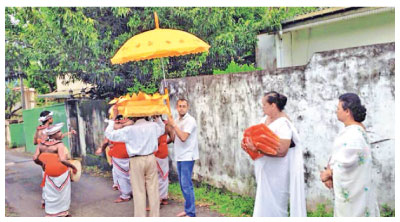Sacred Tradition of Rain Retreat and Katina Robes
Source:Dailynews
The rain retreat begins in Esala and concludes in Vap, marking the end of a three-month period of intensive meditation and study for Theravada Buddhist monastics. It is a time for Buddhists to celebrate with spiritual grandeur, offering new robes and other necessities to the monks as a token of their gratitude and support.
The Pali word Katina means unbreakable, symbolising the strength and resilience of the monastic community. The Katina festival is a joyous occasion that brings together laypeople and monastics to celebrate the Buddha’s teachings and to reaffirm their commitment to the Buddhist path.
The idea of a fixed rain calendar has now become a thing of the past. Yet, our enduring attachment to age-old traditions persists. It exemplifies our steadfast commitment to the annual rainy retreat, irrespective of whether the heavens grace us with their aqueous blessings.
Resilience Through Rain Retreat
This enduring tradition serves as a poignant reminder of our deep-seated connection to the elements and the importance of mindfulness in an era where so much is uncertain. It is a symbol of our respect for the past and our hope for the future, a testament to the human spirit’s ability to adapt and endure in the face of change. So, even in a world where predictability is a rare luxury, the rainy retreat stands as a testament to our enduring appreciation for the cycles of nature and the wisdom of our ancestors.
The Buddha, in the company of his revered disciples, initiated a profound tradition now known as rain retreat or vassana. This practice holds a place of great significance within the Buddhist monastic community, particularly for those who have received higher ordination. The essence of this ritual lies in the unwavering commitment of monks to uphold a strict code of discipline during this period.
The fascinating origins of the rain retreat tradition are steeped in the history and teachings of Buddhism. This observance traces its roots to a remarkable event that unfolded during the Buddha’s lifetime. It was at this juncture that the Buddha’s wisdom and compassion intersected with the practicalities of monastic life.
In the Buddha’s time during the rainy season in ancient India, the monastic community was faced with a challenge. The heavy and persistent rains made it difficult for the monks to travel and gather alms, as well as for laypeople to provide food and necessities to the monastic order. This presented a dilemma, as the monks needed to maintain their wandering lifestyle and fulfill their spiritual duties without causing undue hardship to the laity.
In the Face of Criticism
The Buddha’s monk disciples used to continue their wandering lifestyle even in the rainy seasons. It became a point of criticism and attack from non-Buddhist sects. Detractors accused Gautama Buddha’s followers of causing harm to living beings by walking in the rain, especially during the rainy season. This criticism aimed to challenge the Buddha’s teachings and undermine the moral integrity of his monastic community.
The accusations stemmed from a concern for non-harming (ahimsa), a fundamental ethical principle in many Indian spiritual traditions. Walking through fields and forests during the rainy season could lead to trampling on newly sprouted crops, small creatures, and insects, potentially causing harm to living beings. The non-Buddhist sects used these instances to question the sincerity and moral standing of the Buddha and his followers.
In response to this criticism and to uphold the principle of non-harming, the Buddha introduced the rain retreat or vassana. This period of sustained residence in one place during the rainy season allowed the monastic community to avoid unintentional harm to living beings while also making it more convenient for laypeople to offer alms and support to the monks.
The rain retreat, with its emphasis on disciplined practice and ethical conduct, not only addressed these concerns but also served to deepen the spiritual development of the monks. It became a way for the Buddhist monastic community to maintain their wandering way of life while adhering to the principle of non-harming.
Bridge to Monastic-Lay Community Harmony
In this context, the rain retreat illustrates the Buddha’s ability to adapt and respond to ethical challenges, ultimately strengthening the moral foundation of his teachings. It also highlights the importance of addressing ethical concerns and finding practical solutions within the context of a spiritual tradition’s evolution.
The strict observance of rules and discipline during the rain retreat is seen as an act of devotion and a means to deepen one’s commitment to the path of enlightenment. This period serves as an opportunity for monks to intensify their meditation, study, and reflection, thereby strengthening their spiritual growth.
On the other hand, when monks stayed indoors and meditated, people mistook it. They thought monks suffer a lot, and reported this to King Bimbisara. The good-hearted king invited the Buddha and his followers to his city of Rajagaha.
It was the custom of the Buddhist monks to roam for their alms. This was so even during the rainy periods. This had been, as usual, criticised by the non-Buddhist sectors especially Jains. Their complaints were that the Buddhist monks walk on the lawns and crops. Jains believe destroying plants too is a sinful act. They also opined that during the rainy season, many insect-like creatures come to the ground, and monks’ roaming affects their life. Any being, including even birds, will remain indoors during this season, while the Buddhist monks still roam here and there giving a cold shoulder to natural norms.
The Buddha listened to this, surprised them by ruling that the monks should stay indoors in the rainy season and named it rain retreat. It means vas in Pali, because viseema is dwelling in English. The retreat lasts for three months. The vas actually starts in Esala, which is called pera vas, and what happens in Nikini is called pasu vas. This paved the way to a strong bond between the monks and laypeople, as they get to meet oftener.
This period is considered utmost sacred. Many meritorious activities such as discussion and meditation are carried out. Whenever a layperson builds a new house, h/she invites the Buddhist monks to spend a while during this season.
Path to Spiritual Progress
Offering a Katina robe or actively participating in Katina activities is regarded as a highly meritorious and virtuous act within Buddhist traditions. The Katina ceremony is a special and significant event in which a new robe, known as a Katina robe, is offered to a deserving monk who has observed the rainy retreat or vassa. This tradition is rooted in the teachings of the Buddha and holds great importance within the Buddhist community.
The act of offering a Katina robe or engaging in Katina activities is believed to yield immediate and tangible benefits in the present lifetime. It is considered one of the eight great meritorious activities, which are highly valued in Buddhism for accruing positive karma and creating favorable conditions for a better life and spiritual progress. These eight meritorious activities include giving, ethical conduct, mental development, reverence, service, transference of merit, rejoicing in the merits of others, and teaching or sharing wisdom.
Offering a Katina robe reflects a deep reverence for the Sangha (the community of monks and nuns) and a commitment to the practice of dana (generosity). By actively participating in Katina activities, individuals are not only making a material offering but are also contributing to the communal spiritual welfare.
The merit generated from these acts is believed to bring forth positive results in the form of happiness, well-being, and spiritual progress for the giver. It is thought to create positive conditions for the giver’s present life and future existences.









